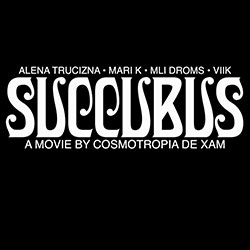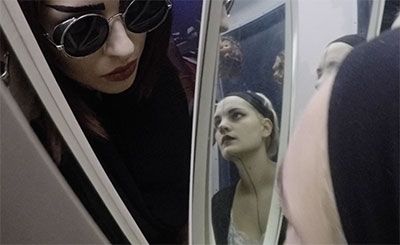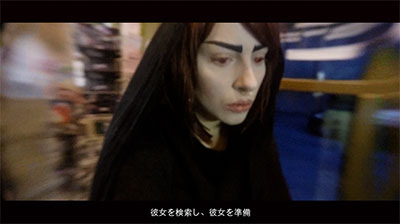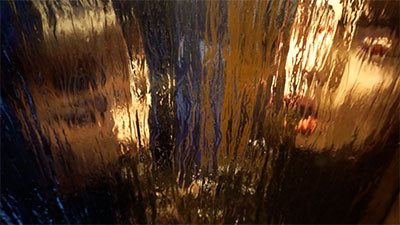Published by Alessandro Violante on August 3, 2016
 All that we see or seem is just a dream. A dream within a dream. The new Cosmotropia de Xam movie, Succubus, starts with these words from Edgar Allan Poe‘s poem A dream within a dream and with a series of spheres which vaguely recall Marcel Duchamp‘s Anemic Cinema. Cosmotropia de Xam, as you’ll probably know, is the man behind Mater Suspiria Vision project who released his previous movie Delirium, reviewed on these pages, some months ago.
All that we see or seem is just a dream. A dream within a dream. The new Cosmotropia de Xam movie, Succubus, starts with these words from Edgar Allan Poe‘s poem A dream within a dream and with a series of spheres which vaguely recall Marcel Duchamp‘s Anemic Cinema. Cosmotropia de Xam, as you’ll probably know, is the man behind Mater Suspiria Vision project who released his previous movie Delirium, reviewed on these pages, some months ago.
Succubus, although quite different from the previous movie, shares with it the theme of possession conceived as a way to escape from a daily life that we don’t like and in which we don’t find our place. The main characters, Alena Trucizna and Mari K, are almost unreal, two cyberpunk anti-heroines, who have made their choice: renouncing to a daily life rich of frustrations and banality to seek refuge in their non-world. A question is raised: who are the succubi? Are they the actresses that reach this state thanks to a drug called Esmakra or are we succubi of a society that depersonalizes us and transforms us into slaves of a system that bring us to our relentless decay? It’s impossible not to think about the theories elaborated by William S. Burroughs and Brion Gisin. Probably the Esmakra is what Burroughs calls “The third mind”, a breaking point of the “Machines of control” that allow us to perceive the world as it really is. That doubt is generated by the movie, a doubt that was raised in Delirium too. Who does win? Who does run away or who does stay? Then, Esmakra becomes the “red pill” ( as in Wachowski‘s trilogy). It’s down to the reader to decide how to watch the movie.
Although Succubus could be perceived as different as far as for the actresses, the soundtrack, the history and the scenario involved, there are also several common elements with the whole series of movies directed by Cosmotropia. He has a complex idea of directing movies, rather than being minimalist, they are the opposite. His frames have other frames within them, adding a further value and meaning to the image. Likewise, the management of time narration changes according to the action. Fast and nervous when characters walk and when they eat, slow in ecstatic and more “personal” moments. Another common element, also here used, is the act of eating spindly objects, tapes in our case. The always recognizable presence of this kind of action can be interpreted in several ways: could it express the enormous mass of information that we eat without pauses and without having the chance to digest it? Maybe yes, maybe not. In this movie, the spindly matter is used as a link between the characters, which constantly eat it in sequences that, sometimes, show a strange sense of eros.
Similarly to Jeremy Bentham‘s Panopticon, the characters live in an anti-place created in their minds, a glass bell in which they are in a neverending ecstasy, and the non narrative voices observe them and give them rules. They are abstract entities, never seen by us, but that have power over the characters. The magical-ritual dimension is always there, and this can be perceived, in particular, in the second part of the movie, in which the actresses seem to participate to a strange initiation rite that brings Alena to a constant state of madness.
There’s a strong difference between the real world (an anti-spatial place) and the mind dimension of the characters. Outside of it a huge estate landscape can ben seen, while the artificial space seems to be made of glass. The movie is dedicated to Hieronymus Bosch, one of the most eclectic and visionary artists of XV° century, who has been considered not so much in the past, and the same visionariety can be found in the movie, in which some fragments of his works can be found.
As far as characterization goes, Alena and Mari are very different from Shivabel and Maya, the protagonists seen in Delirium. If in that movie Maya, although in her silence, clearly expressed her condition, here Alena and Mari are cold in their acting, post-Blade Runner androids-women lost in a dimension that cancel their personality, and their gaze is empty, typical of who is in “another place”.
Another very important element that detaches Succubus from Delirium is technical in nature, due to the different usage of the camera and to the frames chosen by the director. Here the camera is never unstable as it doesn’t express any kind of inner disease (the two characters aren’t victims, but rather caught in ecstasy), and we have several close-ups and first floors, excluding some long shots in the second half of the movie. This choice isn’t casual, aimed at representing the physical and mental state of the characters in the best way possible, characters that, as aforementioned, are physically present but whose minds are absent, lost in their dimension. The empty and cold eyes are always in close-up, as well as their mouths are. For the most of the movie the narrative rhythm is slow, frames are very long, the actresses are fixed in their position and sometimes the images appear out of focus or changed in their colour scale (a tribute to avantgarde cinema). For example it happens in the ballet sequence, in order to highlight their ecstatic state.
Impossible not to consider the role played by the soundtrack, made by several projects already reviewed on these pages. the Songs are very different from each other, used in smart ways in different situations. For example, Sco‘s ĐrØp Ŧhe BØmb is the perfect soundtrack for a sort of bad trip experienced by Alena, while Damn Whore‘s Black opium suits very well with the sequence of the rite, In the first example, an almost electro punk acid moment is apt to the narrow and dark places in which the character find herself, while, in the second, the slow and lysergic rhythm suits well with the walk along the estate that the two characters slowly take to reach their destination.
A multifaceted movie, rich of interpretations, that asks to the viewer the right state of mind and the right inspiration in order to be enjoyed at its best. Another brick in the already rich and various filmography of the director.
Phantasma Disques Filmproduction
Rating: 8, 5





